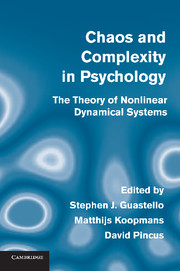Book contents
- Frontmatter
- Contents
- Contributors
- Preface
- 1 Introduction to Nonlinear Dynamics and Complexity
- 2 Collective Intelligence: Observations and Models
- 3 Neurodynamics and Electrocortical Activity
- 4 Psychophysics
- 5 Temporal and Spatial Patterns in Perceptual Behavior: Implications for Dynamical Structure
- 6 Embodied and Embedded: The Dynamics of Extracting Perceptual Visual Invariants
- 7 Origins of Order in Cognitive Activity
- 8 Nonlinear Complex Dynamical Systems in Developmental Psychology
- 9 Developmental Psychopathology: Maladaptive and Adaptive Attractors in Children's Close Relationships
- 10 Psychopathology
- 11 Coherence, Complexity, and Information Flow: Self-Organizing Processes in Psychotherapy
- 12 The Dynamics of Human Experience: Fundamentals of Dynamical Social Psychology
- 13 Group Dynamics: Adaptation, Coordination, and the Emergence of Leaders
- 14 Organizational Psychology
- 15 Complexity, Evolution, and Organizational Behavior
- 16 Agent-Based Modeling Within a Dynamic Network
- 17 Epilogue: Psychology at the Edge of Chaos
- Index
13 - Group Dynamics: Adaptation, Coordination, and the Emergence of Leaders
Published online by Cambridge University Press: 18 December 2013
- Frontmatter
- Contents
- Contributors
- Preface
- 1 Introduction to Nonlinear Dynamics and Complexity
- 2 Collective Intelligence: Observations and Models
- 3 Neurodynamics and Electrocortical Activity
- 4 Psychophysics
- 5 Temporal and Spatial Patterns in Perceptual Behavior: Implications for Dynamical Structure
- 6 Embodied and Embedded: The Dynamics of Extracting Perceptual Visual Invariants
- 7 Origins of Order in Cognitive Activity
- 8 Nonlinear Complex Dynamical Systems in Developmental Psychology
- 9 Developmental Psychopathology: Maladaptive and Adaptive Attractors in Children's Close Relationships
- 10 Psychopathology
- 11 Coherence, Complexity, and Information Flow: Self-Organizing Processes in Psychotherapy
- 12 The Dynamics of Human Experience: Fundamentals of Dynamical Social Psychology
- 13 Group Dynamics: Adaptation, Coordination, and the Emergence of Leaders
- 14 Organizational Psychology
- 15 Complexity, Evolution, and Organizational Behavior
- 16 Agent-Based Modeling Within a Dynamic Network
- 17 Epilogue: Psychology at the Edge of Chaos
- Index
Summary
Introduction
This chapter describes three interrelated topics in group or team behavior that have been developed substantially from the nonlinear dynamical systems (NDS) perspective: adaptive behavior, coordination, and the emergence of leadership. Explanations for all three phenomena would have a great deal of practical relevance. Ironically, there is a growing awareness of the need for NDS concepts within the conventional group dynamics literature that is dominated by linear models and linear relationships. In their comprehensive review of factors related to team performance, Kozlowski and Ilgen (2006) remarked that “teams are complex dynamic systems that exist in a context, develop as members interact over time, and evolve and adapt as situational demands unfold” (p. 78). Others have also made reference to emergent phenomena in groups (Burke, Stagl, Salas, Pierce, & Kendall, 2006; Marks, Mathieu, & Zaccaro, 2001; Tasa, Taggar, & Seijts, 2007). These authors have not mentioned any of the empirical work or theoretical principles of NDS, however, although the connection should be glaring and the relevant NDS contributions were already on record at the time of their writing, if not earlier. Thus the goal of this chapter is to recount the progress within the NDS paradigm in each of these areas.
The current use of the term emergence within the linear community is consistent with Sawyer's (2005) exposition, however: Interactions among individual group members give rise to a supervenient group-level outcome that is not explicable as simply the result of individual actions.
Information
- Type
- Chapter
- Information
- Chaos and Complexity in PsychologyThe Theory of Nonlinear Dynamical Systems, pp. 402 - 433Publisher: Cambridge University PressPrint publication year: 2008
Accessibility standard: Unknown
Why this information is here
This section outlines the accessibility features of this content - including support for screen readers, full keyboard navigation and high-contrast display options. This may not be relevant for you.Accessibility Information
- 2
- Cited by
